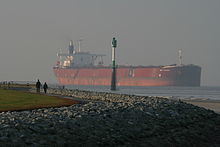
Trondheim Airport, more commonly known as Værnes, is an international airport serving Trondheim, a city and municipality in Trøndelag county, Norway. The airport is located in Værnes, a village in the municipality of Stjørdal in Trøndelag county, 10 nautical miles east of Trondheim. Operated by the state-owned Avinor, it shares facilities with Værnes Air Station of the Royal Norwegian Air Force. In 2018, the airport had 4,441,870 passengers and 58,273 air movements, making it the fourth-busiest in the country. The airport has two terminals; A dates from 1994 and is used for domestic traffic, while B is the renovated former main terminal from 1982, and is used for international traffic. The airport features a main east–west 2,999-metre (9,839 ft) runway, a disused northwest–southeast 1,472-metre (4,829 ft) runway, an integrated railway station and an airport hotel.

Kristiansund Airport is an international airport serving Kristiansund, Norway. It is situated at Kvernberget on the island of Nordlandet and is the sole scheduled airport serving Nordmøre. The airport features a 2,390-meter (7,840 ft) runway aligned 07/25. In addition to scheduled services operated by Scandinavian Airlines and Widerøe, it serves offshore helicopter traffic to the Norwegian Sea operated by CHC Helikopter Service. Kvernberget handled 314,084 passengers in 2018.
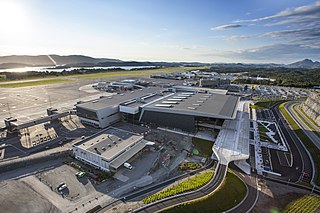
Bergen Airport, alternatively Bergen Flesland Airport or simply Flesland Airport, is an international airport located at Flesland in the city and municipality of Bergen, Vestland, Norway. Opened in 1955, it is the second-busiest airport in Norway, with 6,306,623 passengers in 2018. Flesland is operated by the state-owned Avinor. Until 1999 Flesland Air Station of the Norwegian Air Force was co-located at the airport.
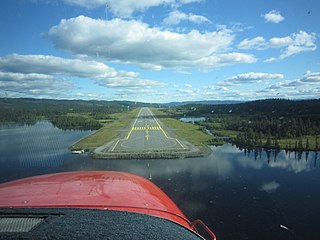
Fagernes Airport, Leirin is a general aviation airport in Fagernes, in the municipality of Nord-Aurdal, Innlandet county, Norway. It has been an airport for passenger flights, serving Fagernes and the surrounding valleys of Valdres, Hallingdal and Gudbrandsdal in Southern Norway, 190 kilometres (120 mi) from Oslo. Opened in 1987, it was owned and operated by state-owned Avinor. The airport is located 822 metres (2,697 ft) above sea level, and has a 2,049-metre (6,722 ft) runway. It did provide a regional service for the local population to Oslo, subsidized by the Ministry of Transport, as well as charter services during winter serving the nearby ski resorts. In 2014, the airport had 6,393 passengers. The driving time Fagernes–Oslo, around 2½ hours, has made flights to Oslo unattractive; most passengers used the Oslo route for transfers. It has also been used for other destinations. The road has also been improved compared to how it was in 1987.

Førde Airport is a regional airport located at Bringelandsåsen in the municipality of Sunnfjord, about 16 kilometers (10 mi) south of the town of Førde in Vestland county, Norway. Owned and operated by the state-owned Avinor, the airport has a single 1,019-meter (3,343 ft) runway numbered 07–25. It is served by Widerøe, which operates De Havilland Canada Dash 8 aircraft to Oslo.
Andøya Airport is a domestic airport located in the village of Andenes in Andøy Municipality in Nordland county, Norway. It is situated on the northern tip of the island of Andøya. The airport is the civilian sector of Andøya Air Station and is operated by the state-owned Avinor. The airport consists of two runways, 2,468 and 1,672 meters long, and served 48,254 passengers in 2012. Widerøe operates public service obligation (PSO) flights to Bodø, Tromsø, Stokmarknes and Harstad/Narvik, while Norwegian Air Shuttle operates seasonal flights to Oslo.

Alta Airport is an international airport serving Alta, a town and municipality in Troms og Finnmark county, Norway. The airport is located at Elvebakken, 4 kilometers (2.5 mi) east of the city center. It has a single, 2,253-meter (7,392 ft) runway numbered 11/29, which lies on the southern shore of the Altafjord. Alta Airport is owned and operated by the state-owned Avinor, and served 368,393 passengers in 2014, making it the busiest airport in Finnmark.

Sørkjosen Airport is a regional airport located at the village of Sørkjosen in Nordreisa Municipality in Troms og Finnmark county, Norway, about 4.5 kilometres (2.8 mi) from the municipal center of Storslett. Owned and operated by the state-owned Avinor, it handled 15,198 passengers in 2014. The airport has a 880-meter (2,890 ft) runway and is served by Widerøe, which operates regional routes using the Dash 8-100 to Tromsø, and some communities and towns in Finnmark on public service obligation contracts. The airport opened in 1974 and was originally served using de Havilland Canada Twin Otter aircraft. Dash 8s were introduced in 1995 and two years later ownership was transferred from Nordreisa Municipality to the state.

Vadsø Airport is a regional airport in Vadsø Municipality in Troms og Finnmark county, Norway. The airport is located in the village of Kiby, 4 kilometers (2.5 mi) east of the town of Vadsø along the Varangerfjorden. The airport is operated by the state-owned Avinor and handled 77,348 passengers in 2014. The asphalt runway is 997 meters (3,271 ft) long. Services are provided by Widerøe using Dash 8-100 aircraft to other communities in Finnmark and to Tromsø International Airport. The routes are subsidized by the Ministry of Transport and Communications through public service obligations.
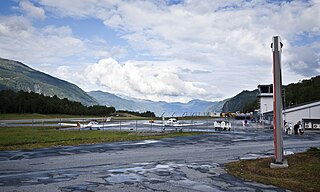
Sandane Airport is a regional airport serving the village of Sandane in Vestland county, Norway. It perpendicularly straddles the Anda peninsula in Gloppen Municipality between the Nordfjorden and Gloppefjorden. The airport has an asphalt runway measuring 970 by 30 meters and aligned 08/26. Services are provided by Widerøe on public service obligation with the Ministry of Transport and Communications. The airport is owned and operated by the state-owned Avinor and served 37,272 passengers in 2013.

Florø Airport is a regional airport serving the town of Florø in Kinn Municipality, in the west central part of Vestland county, Norway. It is situated on the southern shore of the island of Florelandet, adjacent to the town center. Owned and operated by the state-owned Avinor, it features a 1,264-meter (4,147 ft) runway aligned 07/25. The airport had 201,686 passengers in 2014, making it the busiest regional airport in the country.
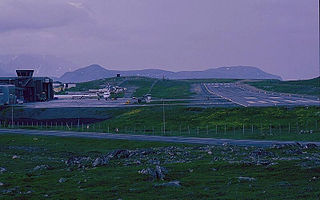
Hammerfest Airport is a regional airport at Prærien in Hammerfest, Norway. It is operated by the state-owned Avinor and handled 145,396 passengers in 2014, making it the third-busiest regional airport in the country. The airport has a 880-meter (2,890 ft) runway aligned 05/23. Services are provided by Widerøe using the Dash 8-100. Up to eight daily flights are provided to Tromsø and public service obligation flights are flown eastwards to other airports in Finnmark. The airport is the base for offshore helicopter services operated by Bristow Norway and CHC Helikopter Service. An estimated 40,000 people from Hammerfest Airport's catchment area annually use Alta Airport for flights to Oslo.

Båtsfjord Airport is a regional airport serving Båtsfjord in Troms og Finnmark, Norway. It consists of a 1,000 by 30 meters runway and served 14,485 passengers in 2016. A further 14,663 landed and started at the airport without leaving the aircraft. Scheduled services are provided by Widerøe using the Dash 8 to Kirkenes, Hammerfest and other communities in Finnmark. The airport is owned and operated by the state-owned Avinor.
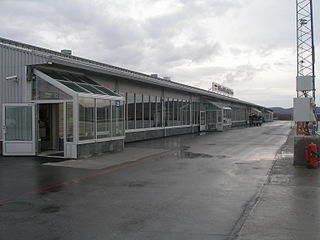
Kirkenes Airport is an international airport located at Høybuktmoen, 15 kilometers (9 mi) west of the town of Kirkenes, in the municipality of Sør-Varanger, Troms og Finnmark county, Norway. Operated by the state-owned Avinor, the airport has a single 2,115-by-45-meter asphalt runway numbered 05-23. Scandinavian Airlines and Norwegian Air Shuttle operate Boeing 737-services to Oslo Airport, Gardermoen, in part generated by Høybuktmoen's function as a hub for Widerøe's regional services to other airports in eastern Finnmark. There are also summer charter flights to Central Europe to bring tourists to the Hurtigruten cruises. The airport had 297,149 passengers in 2013.
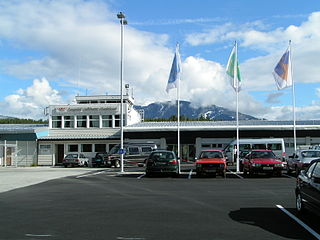
Sogndal Airport is a regional airport serving Sogndal Municipality and the surrounding area in Vestland, Norway. It is situated at Haukåsen, 10 kilometers (6.2 mi) from Kaupanger and 20 kilometers (12 mi) from Sogndalsfjøra. It serves the whole Sogn district. The airport consists of a 1,180-meter (3,870 ft) runway aligned 06/24. Services are provided by Widerøe on public service obligation with the Ministry of Transport and Communications. The airport is owned and operated by the state-owned Avinor and served 70,244 passengers in 2014.

Hasvik Airport is a regional airport serving Hasvik Municipality in Troms og Finnmark county, Norway. The airport is located in the village of Hasvik on the island of Sørøya. In 2012, Hasvik Airport had 7,629 passengers, making it the third-least busy airport operated by the state-owned Avinor. The airport consists of a 909-meter (2,982 ft) runway and is served by Widerøe with Dash 8-100 aircraft. The airport tower is operated remotely from Bodø.

Mosjøen Airport is a regional airport serving the town of Mosjøen in Vefsn Municipality in Nordland county, Norway. In 2014, Mosjøen Airport had 61,480 passengers. It is owned and operated by the state-owned Avinor.
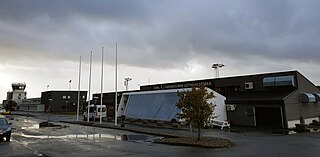
Sandnessjøen Airport is a regional airport serving the town of Sandnessjøen, Norway. The airport is located in the municipality of Alstahaug in Nordland county, 5.5 nautical miles south west of Sandnessjøen. In 2014, Sandnessjøen Airport served 74,138 passengers. It is operated by Avinor.

Berlevåg Airport is a regional airport serving Berlevåg Municipality in Finnmark county, Norway. The airport is situated 2 kilometers (1.2 mi) northwest of the village of Berlevåg and is owned and operated by Avinor. The airport tower is operated remotely from Bodø.

Ørsta–Volda Airport is a regional airport situated at Hovden (Hovdebygda), in Ørsta, Norway, midway between the towns of Ørsta and Volda. The airport features a 1,070-metre (3,510 ft) asphalt runway aligned 06/24. Services are provided by Widerøe using their de Havilland Canada Dash 8 as a public service obligation. Owned and operated by the state-owned Avinor, the airport handled 121,021 passengers in 2014.







